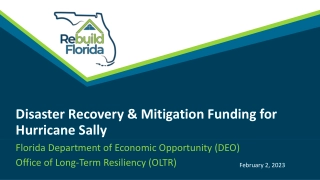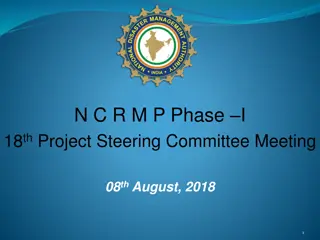Disaster Mitigation & Local Safety Training for Nepali Communities
This training program focuses on understanding disaster risks, particularly earthquakes, in Nepal. It covers topics such as the geographical structure of Nepal, responding to earthquake disasters, local safety mapping, types of disasters (natural and man-made), major disasters in Nepal, and historical earthquake events in the country. The content emphasizes the importance of disaster preparedness and community resilience in mitigating the impacts of disasters.
Download Presentation

Please find below an Image/Link to download the presentation.
The content on the website is provided AS IS for your information and personal use only. It may not be sold, licensed, or shared on other websites without obtaining consent from the author. Download presentation by click this link. If you encounter any issues during the download, it is possible that the publisher has removed the file from their server.
E N D
Presentation Transcript
Training on Disaster Mitigation & Local Safety Map for Local Community 1
Contents Understanding Disaster Disasters in Nepal (Earthquakes in Nepal) Understanding earthquake disaster (basic) Geographical Structure of Nepal Ground level and different effect of disaster Responding to earthquake disaster (being safe and saving others) Local Safety Map 2
What is disaster? An event or fact that has unfortunate consequences. A sudden accident or a natural catastrophe that causes great damage or loss of life. An immediate and emergency situation that has damaged surroundings. An event (hazard, such as storm or earthquake) which creates a serious disruption of the functioning of a community involving widespread human, material, economic or environmental losses and impacts, which exceeds the ability of the affected community to cope using its own resources. Disasters can be natural or human-made. 3
Two (2) types of disasters DISASTERS Natural Disaster Man-made Disaster Earthquake Floods Air/Train crash Landslides etc Nuclear explosion War 4
Major Disasters In Nepal Flood Earthquake Accidents Epidemic Landslides et.c 5
Earthquake disasters in Nepal Date Deaths Mag. 1255, 7 June 2,200 7.8 1260 100 7.1 1344 100 7.9 1408 August 2,500 8.2 1505, 6 June 6,000 8.7 1681 January 4,500 8.0 1767 July 4,000 7.9 1833, 26 August 6,500 8.0 1869, 7 July 750 6.5 1916, 28 August 3,500 7.7 1934, 15 January 8,519 8.0 1966, 27 June 80 6.3 1980, 29 July 200 6.5 1988, 20 August 1,091 6.6 2011, 18 September 111 6.9 2015, 12 May 213 7.3 2015, 25 April 8,922 7.8
Earthquake disaster Tectonic plates are movable around the earth, it moves very slowly and while moving it creates fault lines below the earth s surface. This fault lines holds the energy and when this energy is released we felt it in the forms of shaking of our earth, which we called earthquake.
Nepal Japan Plate Activity on Earth 10
. Geographical structure of Nepal
Himalayan Geological zone classification in Nepal Hypocenter of Nepal earthquake (M7.8)on 25 April 2015 Himalayan Geological zone classification in Nepal 15
Ground level and different effect of disaster
Grade Grade Grade Grade Measure Soft Ground Hard Ground Fault Hypocenter Magnitude M6 M7 M8 M9 When Magnitude is increased 1, earthquake energy is about 32 times bigger. Energy 1 32 times 1,000 times 32,000 times Ex. Nepal earthquake 2015 M7.8 Tohoku Earthquake 2011 M9.0 Relation between Magnitude and Energy level Magnitude and Energy 14
Responding to earthquake We don t need to be the specialist trained in disaster to response to it. We can also respond if we have some basic skills. It may take hours, a day or even weeks for disaster workers to reach your areas. By that time it might be very late, you can start on your own with the help of your community people.
Three steps of responding earthquake disaster 1. Saving you and your family 2. Helping neighbors 3. Town management
Step 1 Saving you and your family Risk mapping/assessment of your house Find safe location inside the house Prepare earthquake action plan and meeting point outside Prepare outside escape routes Carry whistle and blow if your are trapped or injured Learn basic first aid skills Identify safe exit routes (supported with one video and examples) Group/individual work by drawing your living room/house to see risk/resources during earthquake
Step 2 (after your survival and family safety) Save your neighbors Check your neighbors Identify risk groups among your neighbors (senior citizens, pregnant women, single women living alone, Internally displaced population, handicapped, children etc.) Houses located in blind alley etc. Extinguish fire Rescue Support in Evacuation
Step 3 Community/town management (managing safe places or evacuation sites) 83 open spaces identified in a valley Evacuation site control/management Extinguish, rescue, evacuation Safety activities Collaboration with government and aid agencies Collect information Group work and presentation (if time allows)
Save your life Save your town Earthquake hours later 1day later days later Save your life first Check your neighbors Collect information Evacuation site control Check your fire utensil Extinguish fire Extinguish, resucue, evacuation Check your family Rescue Evacuation open Safety activities Extinguish fire Evacuation Collaboration with fire division Collaboration with fire division Time frame of activities in the case of emergency 19
Introduction to Local safety map Identify risk from the videos Small sharing Few minutes walk to identify risk/resources around the simulation hall Sharing and presentation























